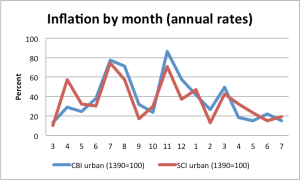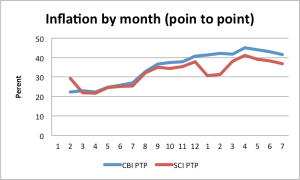Reading inflation in Iran
There seems to be considerable confusion in the Iranian media about the pace of inflation. Since inflation is the main concern of the new Rouhani economic team, getting the facts right about its pace, whether it is rising or falling, is extremely important. There are questions about the accuracy of the official inflation figures, much of it exaggerated, but the most common source of confusion is not about the accuracy of official data but how to read them.
There are at least three ways to interpret the same price index number: point-to-point (which divides the index in one month by its value 12 month earlier), the average annual rate (a 12-month moving average and the government’s favorite when inflation is rising and wants to minimize it), or the monthly rate (which is closest to the speed with which prices are increasing at any particular time and therefore less amenable to manipulation).
There are three official price series (and 75 million unofficial ones!): the Central Bank of Iran (CBI) index of urban prices (1390=2011/2012=100), the Statistical Center of Iran (SCI) urban index (1390=100), and the SCI rural index (1381=100). All three series track each other fairly closely. Here are the monthly inflation rates based on the urban indices of CBI and SCI (annualized for purposes of comparison with the annual rates):

(For an updated graph click here.)
The striking feature of this graph is that inflation has been declining nearly every month since Esfand 1391 (April 2012), long before the Rouhani administration took office.
Now compare this graph to the one for point-to-point inflation (the moving average graph, which is what the CBI usually announces, looks very similar):
Which graph do you look at if you are the governor of the Central Bank of Iran? Clearly, the answer is the one with the monthly rates. The point-to-point graph is misleading because it places the easing of inflation in mid-1392 (summer 2013), whereas the first graph shows that it started six month earlier.
Looking at the point-to-point inflation is like trying to decide if someone is driving dangerously by looking at her average speed during the past hour instead of at how fast she went around a bend (also measured per hour). Cops and traffic judges work with the actual and not some average speed, so should monetary authorities. The whole point of generating timely price data is to know the actual speed at which prices are rising, not their average over the past 12 months.
Why does this matter? Part of the answer is quite obvious. Why should monetary authorities be reacting to high inflation that occurred several months ago now if it has subsided already? The less obvious answer is that they may want to tighten the money supply further, and letting on that inflation is coming down will weaken the resolve of the nation to tolerate austerity. In Iran, at this juncture, exaggerating the inflation rate helps the opponents of the energy price reform — the middle class, energy using businesses in industry and agriculture, among others — to press the government to hold off in raising energy prices and look elsewhere to fix the large budget deficit.
How inflation figures are read in Washington also matters because the dominant thinking on Iran is that continuing high inflation past Rouhani’s election shows that the sanctions continue to hurt, and Iran is in a weaker position than it says it is, so a better deal is possible by being very tough in negotiations (as they seem to be in Geneva this week according to the New York Times).


[…] in recent months. Most people do not know (or do not care) that the drop in inflation rates had already begun a few months before Rouhani came to office. Still, the current tranquility may yet again be […]
As a faithful disciple, poor old Baddu begs you for the baksheesh of a few words – by sparing the time to respond to his posts. After all, he tries to do, what little he could, to nurture your whims. Like when you might have expected him to find out the price of NG Turkey was buying from Iran. Even when you wondered that NG prices in EU may be higher than in the US, he would labor with the bureaucratic Eurostat site – and their queer units – to determine that in the EU-28 the average natural gas price for industrial consumers has been 62 US cents per cubic meter, for the first half of 2013.
I know, even now you are sceptical about Baddu’s latest number and doubt that the Tude’i mafia in or close to the cabinet may have bankrupted The National Iranian Gas Company by paying for such valuable national resource only 3 cents whereas a despised European Capitalist would willingly pay 62 cents – 20 times more – for the same one cubic meter of natural gas.
Please Note!
Turkish Natural Gas Import Prices For 2013 Average 40 to 50 US Cents Per Cubic Meter
On 11 October Turkey’s Taraf newspaper reported [subscription only] that Ankara was paying $570/thousand cubic meters of gas from Iran, the highest price which Turkey has ever paid – earlier this year media reports cited Iranian prices at $507/tcm.
http://www.naturalgaseurope.com/turkish-gas-sector
Thanks for the information. These are 4-5 times prices in the US, and 20% higher than prices in Europe. This is a very high opportunity cost for gas that is sold domestically (about 3000 rials per cubic meter, about $0.10 cents?)
Beg your pardon!
In iran natural gas is sold at 700 rials per cubic meter and NOT at 3000 rials per cubic meter. Yes, even less than $0.03 per cubic meter. We RANTKHARAN know no shame!
Thanks for the timely reply, i was getting worried.
A freind sent me this piece of news in Persian after the above comment was posted. Don’t you think simple cronyism could be the reason for inaction? By the way the gas price decreed is not much different from what you suggest.
به گزارش خبرنگار اقتصادی خبرگزاری فارس، در برنامه هفته گذشته ثریا که از شبکه اول سیما پخش میشود، مسئله قیمت پایین خوراک گاز پتروشیمی ها و سود کلان پتروشیمیهای گازی بخاطر آن و عدم اجرای مصوبه ستاد تدابیر ویژه اقتصادی برای افزایش این قیمت به 325 تومان، در بخش پیگیری تلفنی برنامه مورد توجه قرار گرفت و محمدحسن پیوندی، معاون مدیرعامل شرکت ملی صنایع پتروشیمی مهمان آن بود.
پیوندی در بیان دلیل عدم اجرای مصوبه ستاد تدابیر ویژه اقتصادی درباره افزایش قیمت خوراک گاز به 325 تومان که قرار بود از مهر 91 اجرایی شود، ضمن اشاره به اینکه شرکت ملی صنایع پتروشیمی ارتباطی با بحث خوراک ندارد و پتروشیمیها که خصوصی هستند خوراک را از دولت یعنی شرکت ملی گاز ایران و شرکت ملی نفت ایران دریافت میکنند، گفت: در آن زمان که افزایش قیمت خوراک به تصویب رسید چالشی بین شرکت ملی گاز ایران و شرکت ملی نفت ایران با پتروشیمی ها وجود نداشت و الان اگر چالشی وجود دارد مربوط به نحوه خصوصی سازی است.
معاون مدیرعامل شرکت ملی صنایع پتروشیمی در پاسخ به اینکه از چه زمانی قانون افزایش قیمت خوراک پتروشیمیها اجرا میشود،گفت: خوراک را شرکت ملی گاز و شرکت ملی نفت میدهند و نقش شرکت ملی پتروشیمی بیشتر جنبه نظارت و حساسیت و ایمنی دارد اما هر تصمیمی که دولت، ستاد تدابیر ویژه اقتصادی و شورای عالی امنیت ملی بگیرند باید زودتر اجرا شود.
پیوندی اگرچه از ارائه پاسخ روشنی به اینکه از چه زمانی این مصوبه قانونی اجرا میشود خودداری کرد اما قول داد در صورت اختصاص یکی از قسمت های برنامه ثریا درباره این موضوع، در آن برنامه شرکت کرده و به سوالات مرتبط پاسخ دهد.
در بخشی از این گفتوگوی تلفنی، محسن مقصودی، مجری برنامه ثریا، میزان ضرر ناشی از عدم اجرای مصوبه ستاد تدابیر ویژه اقتصادی برای افزایش قیمت خوراک پتروشیمی های گازی به 325 تومان را روزانه حدود 14 میلیارد تومان، ماهانه 420 میلیارد تومان و در 13 ماه گذشته یعنی اول مهر91 تاکنون قریب به 5 هزار میلیارد تومان اعلام کرد. چ
“In Iran, at this juncture, exaggerating the inflation rate helps the opponents of the energy price reform — the middle class, energy using businesses in industry and agriculture, among others — to press the government to hold off in raising energy prices and look elsewhere to fix the large budget deficit.”
Some opponents of the energy price reform may actually be Natural Gas Smugglers working under the guise of petrochemical exporters. The spectacular rise in the index of Tehran Stock Exchange has been almost solely fueled by the up to 80 fold increase in share prices of these companies over the past two years, when not only domestic prices for petrochemicals were allowed to rise, but the dollar jumped three fold in Rial terms, without affecting domestic gas prices. I explain:
Even natural gas price harmonization faces a stone wall. From personal experience, I can confirm that all cement producers in Iran would prefer to use natural gas, piped to their plants, over heavy fuel oil (HFO) which is sold F.O.T. and has to be hauled to the plant with costly warming to transfer into huge storage tanks and would need warmed piping to reach the burners. Natural gas is more desirable even at a premium of 20% over heavy fuel oil of the same BTU content. Yet the new Rouhani team of economic minded technocrats, continue to sell natural gas delivered to all industrial plants at a 70% discount relative to BTU equivalent of heavy fuel oil! Why so? When just correcting this discrepancy would bring in Rls 300,000,000,000,000 or $10,000,000,000 in additional revenues without even touching fuel prices at petrol stations. At present natural piped gas is sold at 3 cents per cubic meter to the industry, equivalent to selling HFO at less than $5 per barrel delivered! Why? I suggest you ask Mr. Zangane, the minister responsible, for a plausible reason or I would have to come up with my favorite conspiracy theory that could point out to the involvement of many cabinet associates in the petrochemical industry, where products from this dirt cheap natural gas are exported at international prices. Export sales are not taxable in Iran!
Now try to bring in full energy price reform. All the rich people start worrying about what would the poor do! But you rightly state that richer people are by far the real beneficiary of very low energy prices, So why bother to sort out the rich from the poor? Or where they live or even their National Identification Number? Just increase fuel prices to half the Turkish levels, collect the revenues, set one third aside ($40,000,000,000) and divide the rest ($80,000,000,000) equally among the population. Every Iranian shall receive more than $1000 annually. This gives $500 a month to a family of six. Surely the lower income people would gain several fold; whereas, the richer creatures are not the types to set fire to fuel pump stations. Besides, the hole in the budget would more than be fixed by the $40,000,000,000 which was set aside. Q.E.D.
Reply
An informative post from you, as usual. I suppose the reason for not increasing the price of natural gas to producers is that it increases inflation. This is the reason why I have argued (in Donayaey Egteshad http://www.donya-e-eqtesad.com/news/765815/) that in the short run consumer prices can be increased. In general, I do not think inflation is a good reason to subsidize energy prices, any more than it is advisable for any country to fight inflation by subsidizing energy.
The natural gas price of 3 cents per cubic meter that you mention is about one-third of the price in the US, which is lower than prices in Europe. Pricing of natural gas is difficult,as you know, because there is not global market, only local markets. Iran’s alternative user is Turkey and hopefully soon Pakistan. I do not know what price Iran is charging Turkey now. Perhaps the local price in Iran could go up to 10 cents.
I agree with you about the distributional benefits of increasing prices and doing something useful with the proceeds, though I doubt the numbers will be nearly as high as you estimate. If and when prices are increased, the benefits should go to the poor only, and perhaps not in the form of cash by targeted social expenditures.
Thanks for your kind reply. Decades of observing the workings of Iranian bureaucracy has educated me to how long-lasting important policies are implemented. Furthering the cause of certain interest groups is the real reason behind most important policy decisions. At the same time, the same interest groups concoct benevolent pseudo-reasons in order to bring the rank-and-file to support the policy. Otherwise, how can one explain the once-off Natural Gas Price Harmonization which reduces mis-allocation of resources, taxes the rich and energy-moguls , creates new jobs and – not least – reduces budget deficit, construed as causing inflation? If these guys were serious about such measures for inflation control, they should have continued their old, decade-long policy of bank robbery – pegging the dollar to Rial at a fixed parity of 70 –, continuously claiming that the policy was stopping double-digit inflation. At least inflation control through currency-fixing is still a best-seller among the Tudeh’i minded economists and inteligencia.
Coming back to the generally agreed energy price reform, one can look at the ernest search for the names and whereabouts of the rich, in order to restrict cash payment from proceeds to them, in two ways. Honest well-meaning people would see social justice in not rewarding the very same rich who according to you are the real collectors of present subsidies, by a factor of 15 to one. But skeptical people like me, and the majority of rich people and the energy-wasting industrial chiefs, would see in the futile, time-consuming and devisory idea of sorting the rich from the poor as a god-sent opportunity to continue milking the economy for a while longer. Better end decades of misappropriation in one go – marg yekbaar, shivan yekbaar – ,compromise absolute justice and pay the rich as though they were poor!
Who sees the value of the loot better? Those like me who have been looting for years or you learned,honest people who take ages to find out how we do it and dispute ages among yourselves on the best way to catch us?
I may regret later having put the case in such terms,